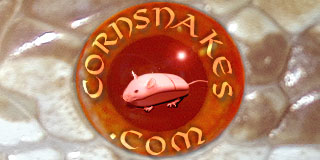From my retired SerpenCo.com website.
Opal Corn Snake
This particular cultivar has been known previously as the 'Amelanistic Lavender Corn'. Kind of a mouthful, isn't it? Sometimes when you work with a particular cultivar long enough, a name seems to develop on it's own that seems fitting and appropriate for the look of the animal. Anyone whom has ever admired the beauty of an opal can appreciate when this fits so well for the Amelanistic form of the Lavender corn. And just as each opal (the stone) has it's own unique characteristics, so too will each of the animals bearing this name. I expect over time, the Opal corns themselves will get further segregated into finer divisions as we selectively breed for one influence in favor of another.
Now this is a fairly new cultivar on the scene. I've been producing a few here and there over the last several years, but only sold a few of them in 1999 for the first time. Lavender in itself is a puzzling genetic trait and combining it with Amelanism only really answered the question of whether Lavender was an odd form of Amelanism or not. Of course, we know now that it is not, but the ruby red eyes usually seen in the Lavender still puzzles us all. There have been cases of pure white amelanistics (sometimes referred to as 'Pearl Corns') coming from the Lavender line, but as of this date, we are not certain what exactly produces this alternate cultivar. At one time I thought they were a triple homozygous combination of Lavender, Amelanism and 'A' Anerythrism. But from some more recent examples I have raised up, I am now pretty much convinced this line is nothing more than an influence of the normal colored stock it came from. In all instances in my own stock, this variation comes from animals in which the normal coloration is more of a Miami Phase looking appearance. On the other hand, the ones that have more ranges of coloration in them tend to be from stock that leans more towards the Okeetee Phase with much more orange content to the ground color. Although I am not ready to take this hypothesis to the bank quite yet, this is the speculation that is leading the pack at the moment.
I don't really have an overwhelming number of adults to be able to give an accurate assessment of how much variability the coloration will be in this cultivar, but like the Lavender, the coloration seems to go through pretty radical changes as they grow and mature. Babies through about three feet in length can have very pronounced pastel shades of orange, pink, and lavender, but mostly in the ground color, with the blotches tending to be much lighter, almost white. In some respects they look like a negative of a snow corn in that in a snow corn it is the ground color that is mostly white and the blotches that have more color to them. When they reach full maturity, the colors become much more subdued with much of the pastel coloration fading quite a bit. They actually will more resemble a Blizzard corn in that the pattern is very indistinct. Since this is a rather new cultivar available, I expect selective breeding to produce some dramatic variations in this line. Since the stock that the Lavenders originated from has tendencies to be rather Miami phase in coloration, perhaps breeding lines that have LOTS of reds and oranges to them will produce animals that will carry these colors on into full adulthood. One can't help but wonder what one of these would like like with Fluorescent Orange or Amelanistic Okeetee as some of the ancestors.
